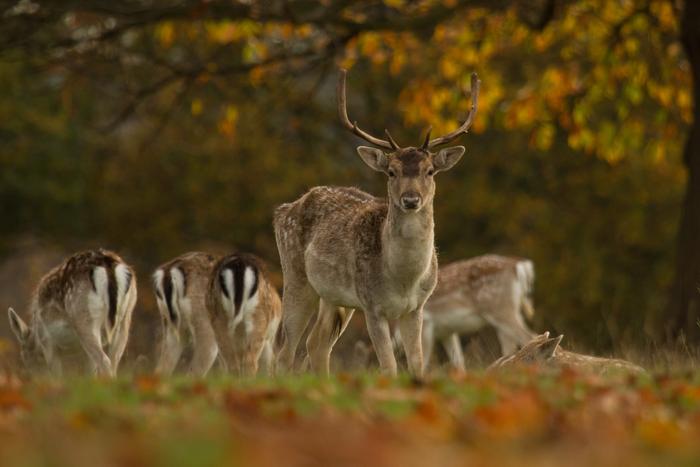Genetic analysis and archaeological insight combine to reveal the ancient origins of the fallow deer
Modern populations of fallow deer possess hidden cultural histories dating back to the Roman Empire which ought to be factored into decisions around their management and conservation.
New research, bringing together DNA analysis with archaeological insights, has revealed how fallow deer have been repeatedly moved to new territories by humans, often as a symbol of colonial power or because of ancient cultures and religions.
The results show that the animal was first introduced into Britain by the Romans and not the Normans, as previously believed. They also reveal how British colonial links during the 17th-19th centuries played a key role in spreading the deer around the world, including the Caribbean island of Barbuda, where fallow deer are the national animal.
The research, conducted jointly by Durham University and the University of Exeter, compares contemporary fallow deer records with zooarchaeological samples dating back 10,000 years.
Funded by the Arts and Humanities Research Council, the work has been published in two new studies, simultaneously. The 10,000-year biocultural history of fallow deer and its implications for conservation policy is featured in the latest edition of PNAS, while Ancient and modern DNA tracks temporal and spatial population dynamics in the European fallow deer since the Eemian interglacial is published in Scientific Reports.
Dr Karis Baker, Department of Biosciences, Durham University, said;
“Over the last 10,000 years, humans have manipulated fallow deer populations with varying outcomes.”
“Persian fallow deer (Dama mesopotamica) are now endangered, while European fallow deer (Dama dama) are globally widespread and simultaneously considered wild, domestic, endangered, invasive and are even the national animal of Barbuda and Antigua.”
“But despite this close association with people, there has been little consensus regarding their natural ranges or the timing and circumstances of their human-mediated translocations.”
Using several hundred DNA samples extracted from both modern and archaeological deer specimens around the world – including the oldest sample so far sequenced from the UK at 130,000 years old – the researchers were able to generate an evolutionary history ‘tree’ for the animal.
The analysis revealed two distinct European fallow deer populations. The first originated in the Balkans and extended right across Southern and Western Europe during the Iron Age and Roman Empire – including to England – but today survives only in pockets of Spain, Italy and the Greek Islands.
The second originated in Anatolia and remained relatively isolated until it was brought to Britain in 1000 AD, from where it was taken around the world. A third group – the Persian fallow deer – was once widespread throughout southwest Asia but is now listed as Endangered by the International Union for the Conservation of Nature.
Professor Rus Hoelzel, in the Molecular Ecology Group, Durham University Department of Biosciences, said;
“These data provide a number of fascinating insights.”
“For example, populations in southern Europe show indications of being stable for extended periods of time suggesting very early translocation from a likely glacial refuge in the Balkans.”
Combining the genetic data with archaeological and historical records enabled the team to build a picture of how fallow deer has been translocated by people at different times and in varying cultural contexts. The animal’s strong association with Greco-Roman goddesses Artemis and Diana, for example, would have driven much of its movements around the Mediterranean during the Bronze Age, Iron Age and Roman period.
The team identified the earliest evidence of fallow deer beyond the Mediterranean at a Roman palace in Fishbourne, in what is now West Sussex, and found evidence to suggest the animal remained in the country for several hundred years before becoming extinct. Several centuries later, deer originating from the Anatolian population were then reintroduced around 1000 AD, just before the Norman Conquest, and it was this population that, in turn, was exported around the British Empire.
This practice was referenced in the 17th century Dutch hunting manuscript, Jacht-Bedryff, for example, which states that Maurice of Nassau, later the Prince of Orange, acquired 100 fallow deer from England to stock The Hague Forest. Historical records also show that Anatolian fallow deer were exported to the island of Barbuda by the Codrington family of Gloucestershire, where its cultural status has changed from symbolising colonial dominance to freedom, following the emancipation of slaves in 1834.

Naomi Sykes, Lawrence Professor of Archaeology, and Head of University of Exeter’s Department of Archaeology and History said;
“These findings overturn much of what we thought we knew about the origins and the spread of fallow deer.”
“Worshipped as Greco-Roman deities, fallow deer have been subject to repeated translocations, largely as symbols of cultural power, and this means that, today, they very much expose the limitations of labels such as ‘domestic’, ‘wild’ ‘endangered’ and ‘invasive’.”
The authors say that the example of Barbuda, where the deer is afforded no legal protection due to its alien status – despite being the national animal – has implications for conservation principles.
Professor Sykes said: “Conservation policy is invariably based on contemporary or recent understanding of an animal’s status, such as how and when it was introduced. But while many species may legitimately be labelled as invasive, this is not true of all translocated populations, some of whom are critically entangled with human history and might offer valuable cultural heritage or a conservation resource.”
Bibliographic information:
Baker, K.H., Gray, H.W.I., Lister, A.M. et al. Ancient and modern DNA track temporal and spatial population dynamics in the European fallow deer since the Eemian interglacial. Sci Rep 14, 3015 (2024), DOI: https://doi.org/10.1038/s41598-023-48112-6
Baker, K.H., et al. Tracking fallow deer over 10,000 years re-writes their biocultural history and has implications for wildlife management policy, PNAS, 121 (8) e2310051121, DOI: https://doi.org/10.1073/pnas.23100511
Press release from Durham University.


